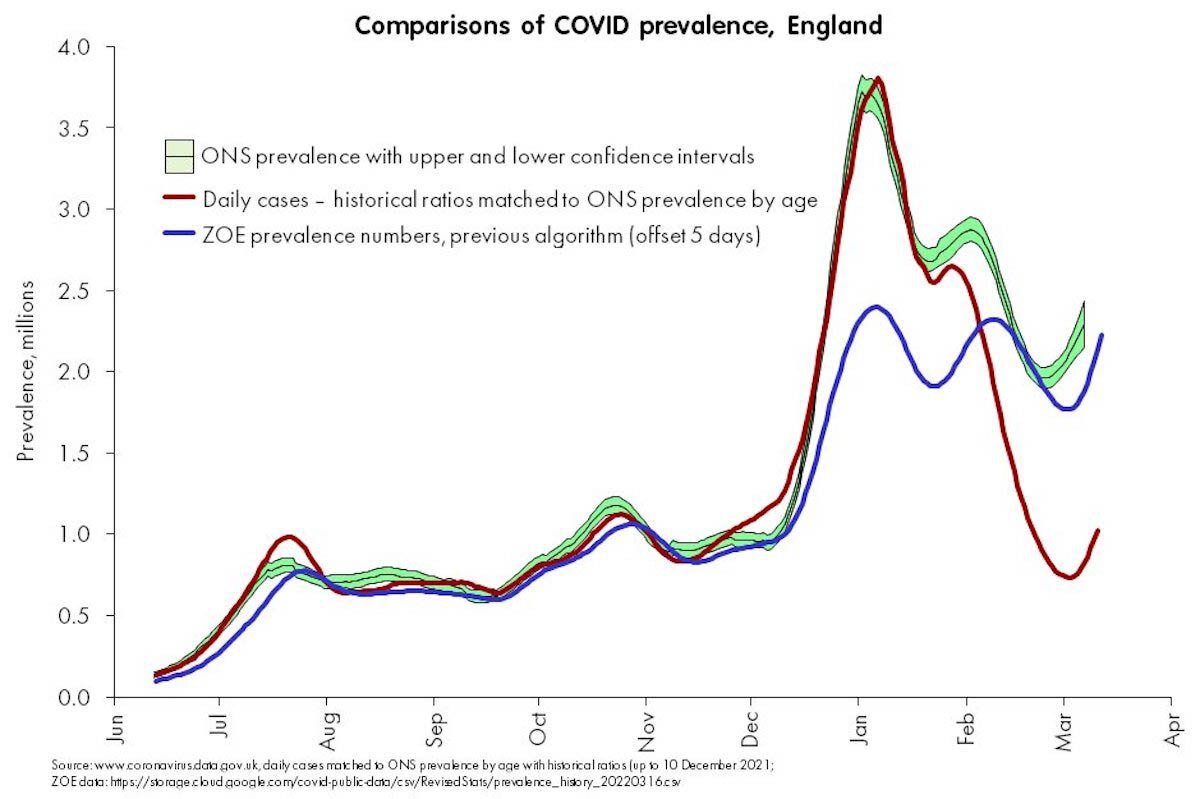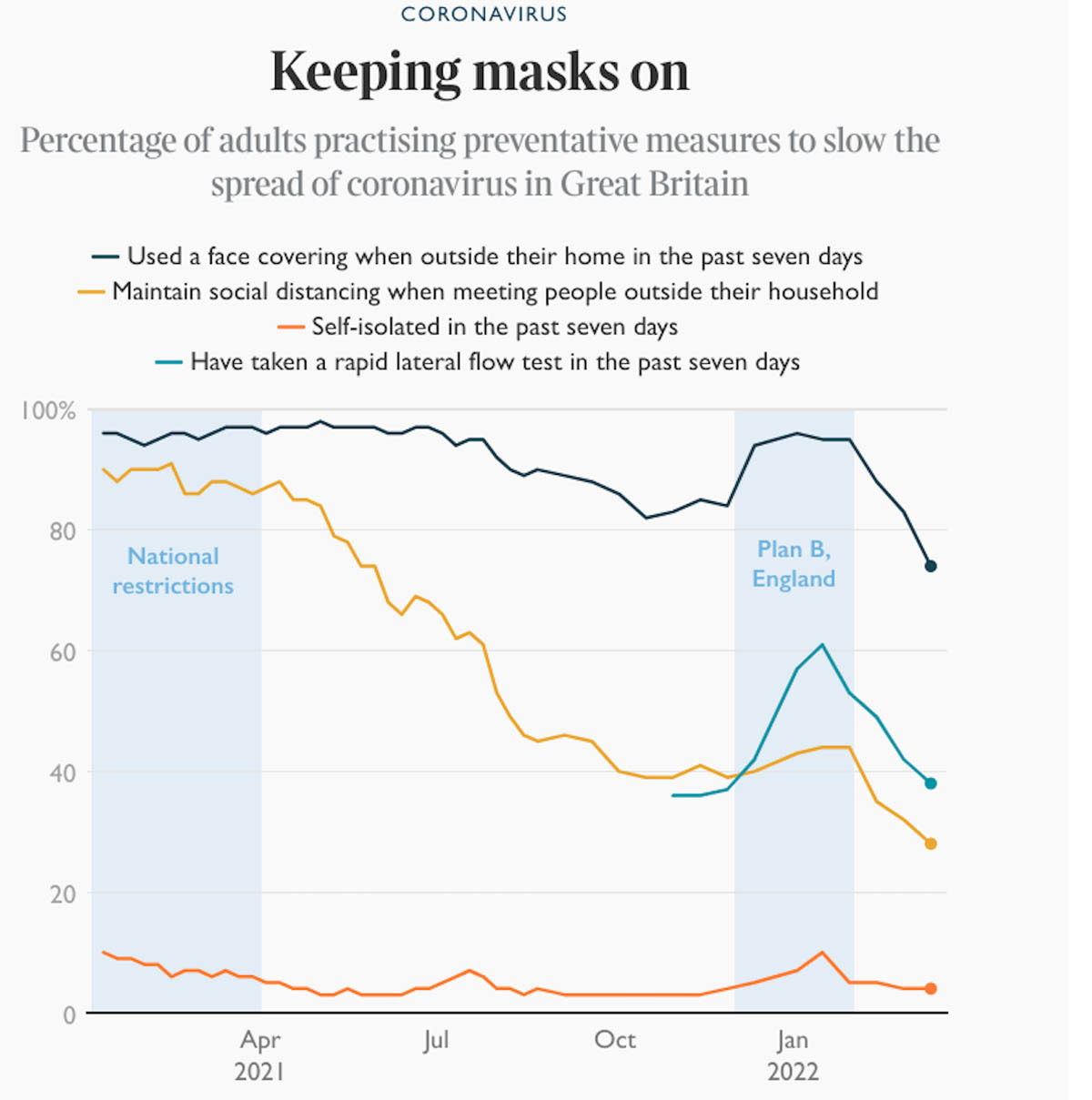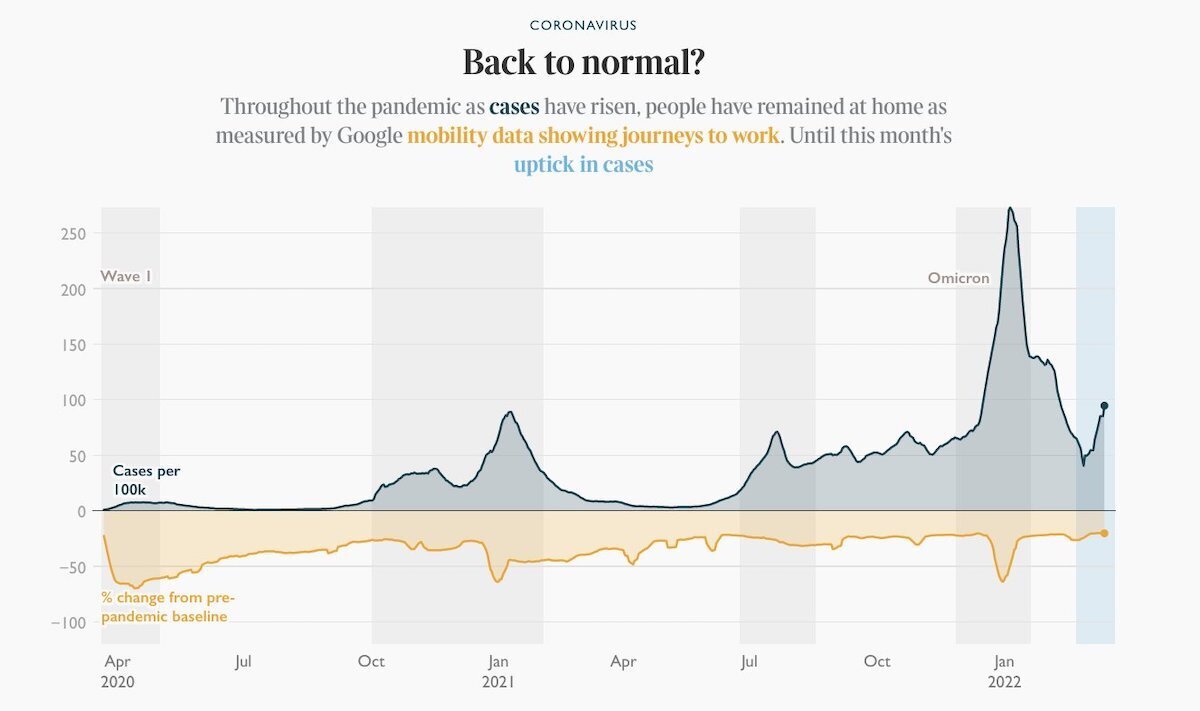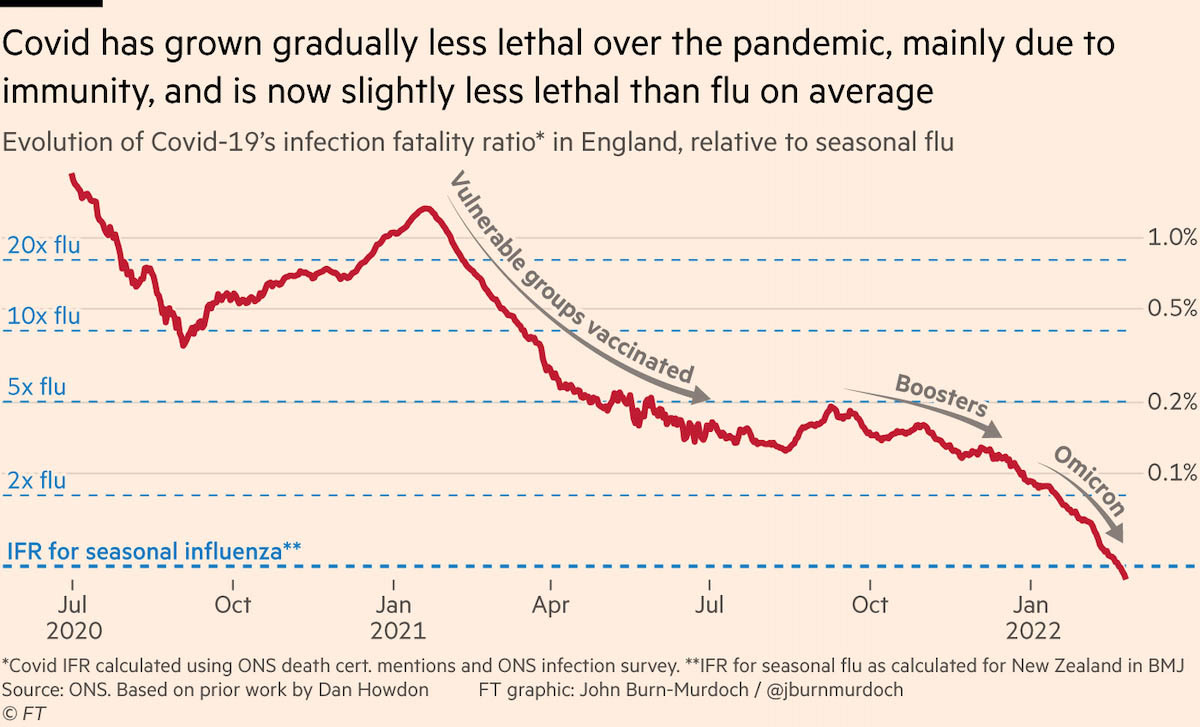
Almost two years since the first pandemic safeguards were introduced on 23 March 2020, unvaccinated people arriving in the UK will no longer have to take tests, and passenger locator forms have been scrapped. The testing rule had already been lifted for people who have been vaccinated, and the government removed the last of their pandemic safeguards earlier in the month. Emma Monk lays out the risks.
The safeguards included mandated isolation if infected, financial support for isolation, contact tracing, the need for close contacts to test daily, the need for unvaccinated close contacts to isolate, and the need for a confirmatory PCR test following a positive lateral flow test (LFT). These all ended on the 24 February. The legal requirement to wear masks in shops and on public transport ended in January.
All the emphasis now appears to be on vaccines and treatments. Yet we know that the effectiveness of vaccines wanes over time, especially as new variants emerge, and the old saying of ‘prevention is better than cure’ holds true with Covid. Working towards preventing people becoming infected is far better for society, not to mention the economy, than relying on a limited number of drugs available to treat people once they become sick.
I will take a look at what losing each of these protective measures is likely to mean.
Testing
After 1 April, free PCRs and LFTs will no longer be available to the general public. PCR tests will remain free for elderly and most vulnerable people in order for them to test quickly and gain access to therapies that need to be taken early on in the infection.
In his speech to parliament on 21 February 2022, Boris Johnson said “we are working with retailers to ensure that everyone who wants to can buy a test”. What that means in reality is that everyone who wants a test and can afford a test can have one. Two years into a pandemic that has disproportionately impacted the poorest and most vulnerable in our society, we are heading towards yet more health inequality.
In practice, this ending of free tests will mean that the vast majority of people who have symptoms won’t bother testing. They will have no idea if they have a cold, or Covid. If symptoms are mild, they will go about their day-to-day business, spreading Covid to their colleagues, other passengers on public transport, and anyone else unfortunate enough to find themselves indoors with them.
The ability to take a quick LFT for reassurance before going to see an elderly relative or vulnerable friend has been taken away. Sadly, this is likely to lead to yet more isolation and loneliness for those who have spent most of the last two years shielding.
The end of routine testing has another detrimental impact, and that is on monitoring of Covid levels in the UK. Knowing where cases are rising, and in which age groups, before that starts to impact on the local hospitals, is vital for planning. So is checking Covid samples for new variants, which can only be done on PCR samples. Removing all mitigations designed to limit the spread of Covid is bad enough, but removing our ability to actually monitor the disease is disastrous.
Donald Trump once said testing “makes us look bad”, asking people to “slow the testing down, please.” He said, “When you test, you create cases.” It was a daft concept then, and it is a daft concept now. Testing gives us knowledge and empowers us.
Fortunately, it seems that funding will remain, for now, for the Office of National Statistics (ONS) to continue their Covid survey, which does give us the most accurate information on prevalence, albeit a week behind the dashboard data that has become so familiar. Since mid-January, when people seemed either to stop testing or stopped reporting their results, the ONS figures (in green on the graph below) have diverged significantly from what is reported on the government dashboard (in red), making the daily dashboard figures fairly worthless now.

One other source of information to which we still have access is the ZOE data (in blue on the graph above), which is from a large self-report survey. It has done a great job in tracking Covid data right down to a really local level throughout the pandemic. Unfortunately, it looks like their funding is being stopped soon. More details, and what you can do to lobby to help keep their funding going, can be found here.
Isolation
Boris Johnson said in Parliament, “Until 1 April, we will still advise people who test positive to stay at home. After that we will encourage people with Covid symptoms to exercise personal responsibility, just as we encourage people who may have flu to be considerate to others”.
This will have a really big impact on the spread of Covid. Isolation of an infected patient is the most fundamental part of any public health campaign, as it is the most effective way to slow the spread of the disease. Removing the mandate to isolate has led to mixed messages, with many people assuming that they can go about their day as usual, as long as they feel all right. Schools and workplaces are now grappling with what guidance to give people with Covid. Should they insist that to minimise disruption, people with Covid come in, or should they ask people to stay away, to avoid infecting others?
The government has also removed the small amount of financial help that was available to those who needed to isolate. Without any money coming in, many self-employed and ‘gig-economy’ workers will simply be unable to follow the ‘advice’ to stay at home. With the cost of testing being a luxury that many will be unable to afford, alongside the removal of any financial help to isolate, we are likely to see an even greater health inequality gap, with wealthier communities seeing far less Covid than the poorer ones.
A further consequence of the removal of isolation is what it means for people who are clinically more vulnerable to Covid. They have had the reassurance until now that people with Covid had to stay at home, so they were less likely to be sharing an office, train carriage or supermarket checkout queue with them. That reassurance has now vanished, leaving them with the painful decision either to go out and put themselves at high risk, or return to self-imposed isolation while Covid cases remain so high.
Finally, asking people to take ‘personal responsibility like they would for flu’ is fundamentally flawed because the diseases are so different. As soon as you know you have flu you are pretty much tucked up in bed because you feel so rubbish: you are automatically isolating yourself. Because Covid is so infectious just before it develops and during early symptoms, when people often don’t feel too bad, they need to make a conscious decision to take themselves out of circulation. Dropping official advice to stay at home if you have Covid after 1 April seems very badly thought-through.
Masks
Research around the world shows that rules are the dominant driver of behaviour. Most people wore masks when that was the rule. Once it is no longer the rule, people stop wearing them, even if they know it’s the right thing to do. Once the number leaving masks off reaches a critical mass, it becomes much harder to wear a mask, as you are in the minority. Anti-mask messaging by certain politicians and people in the media adds to the idea that you only wear a mask if you are scared or weak.
We know masks work to limit the spread of Covid. They cost very little, are a minor inconvenience at worst, and they protect those around you. There is absolutely no scientific, public health, economic or logical reason to get rid of mask laws, other than pure ideology. As they are a very visual reminder that life changed with Covid, so they cause a problem for those in power who appear to want to pretend Covid is over. The new message is: please go back to your offices, and don’t forget to buy your daily newspapers and Starbucks, so that city-centre landlords, media moguls and business owners don’t suffer.
Isn’t it down to individuals to take personal responsibility now?
Public health has never been about individuals having to navigate infectious diseases by themselves. That’s why we have vaccination programmes, environmental standards, laws around clean drinking water, food hygiene regulations and public information campaigns. We don’t tell drivers to use their own judgment over how fast to drive or whether or not to stop at junctions. We have speed limits and traffic lights. Removing testing and reporting guidelines means people are even less likely to be able to make informed decisions. It’s like telling someone not to speed but removing their speedometer.
No individual can control the amount of infection they are exposed to in their community, other than by choosing to stay isolated from others. (Wearing a well-fitting mask obviously helps!). That’s why we need communal measures in place to try and reduce everyone’s exposure.
What are the consequences of lifting all protective measures?
Unfortunately, a few weeks on, ONS data show that cases are rising in all areas of the UK and in all age groups. Hospital admissions have also been rising consistently too. This rise includes both those being treated primarily for Covid, and those being treated for something else but found incidentally to have a Covid infection. It’s worth remembering that the latter group will often comprise people being treated for things like a stroke or heart attack, which were brought on by the Covid infection.
When cases have been rising in the past, public behaviour tended to mirror the rise, in terms of limiting interactions and increased mask-wearing. Unfortunately, those actions do not appear to be happening this time round. Instead, government and media messaging that the ‘pandemic is over’ seems to have taken hold.


But isn’t Covid just like flu now?
In a previous article I wrote about the fact that Covid has not become ‘mild’, and that future variants will not necessarily be milder.
The Financial Times recently produced a graph on infection fatality rates (IFR) – the percentage of people who die after catching a disease. It showed that we had reached a point where the IFR of Covid was now the same as for seasonal flu.

While this is obviously good news because it shows that vaccines and improved treatments are doing their job, too many people have misinterpreted this and declared: “See, we always said it was no worse than the flu”. It is vital, first, that people appreciate the IFR is only that low in a highly immunised population, like in the UK. Second, most importantly, IFR is not the only factor that matters.
Rabies kills 100 per cent of people who get infected (ie, it has an IFR of 100 per cent), but there have only been 12 deaths in the UK in the last 20 years from rabies. Flu has an IFR of around 0.05 per cent and causes around 1,000 deaths a year in the UK. Omicron has a similar IFR but is causing around 1,000 deaths per week in the UK!
So what’s the other important factor?
Prevalence also matters – that is, how much of the virus is present in the population. In other words, how many people have Covid now? The ONS report of 18 March 2022 shows that as of the week ending 12 March, 1 in 20 people in England were infected with Covid. That’s 2.6 million people. This means that your chance of being in close proximity to someone with Covid is incredibly high. Even in the worst flu seasons you will never be anywhere near as exposed to flu as you are to Covid.
So, an individual’s chance of dying may be similar if infected with either Covid or flu, but the chance of someone getting either virus in the first place differs wildly. The effect on the population is also far, far greater: 0.05 per cent of millions of cases (of Covid) leads to thousands of deaths.
Conclusion
The removal of all restrictions has, unsurprisingly, led to another uptick in cases and hospitalisations. The messaging around the pandemic being ‘over’ and Omicron being mild has meant that, unlike in the past when cases started to rise, the UK’s population is not becoming more cautious.
Precautions like mask-wearing, working from home and limiting interactions with others have all continued to decline during February and March 2022. People have stopped testing and, anecdotally, it seems that even those who have tested positive are choosing to go about their daily lives because they ‘feel fine’. Unfortunately, vaccination booster rates have plummeted because ‘Covid is now mild’. The messaging that Covid is mild and is basically over, is giving people the impression that there is no longer a need to take any precautions. Sadly, this does not bode well for the coming weeks and months.




